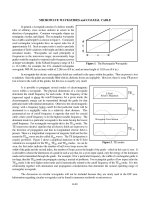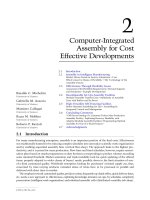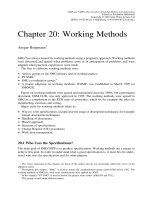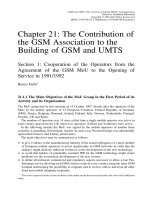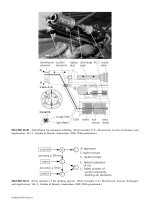Environmental Disasters, Natural Recovery and Human Responses pptx
Bạn đang xem bản rút gọn của tài liệu. Xem và tải ngay bản đầy đủ của tài liệu tại đây (5.95 MB, 229 trang )
Environmental Disasters, Natural Recovery
and Human Responses
Natural disasters destroy more property and kill more people with each
passing year. Volcanic eruptions, earthquakes, hurricanes, tsunamis,
floods, landslides, fires and other natural events are becoming more
frequent and their consequences more devastating. Del Moral and
Walker provide a comprehensive summary of the diverse ways in which
natural disasters disrupt humanity and how humans cope. Burgeoning
human numbers, shrinking resources and intensification of the
consequences of natural disasters have produced a crisis of unparalleled
proportions. Through this detailed study, the authors provide a
template for improving restoration to show how relatively simple
approaches can enhance both human well-being and that of the other
species on the planet. This book will appeal to ecologists and land
managers, as well as anyone curious about the natural world and
natural disasters.
ROGER DEL MORAL is Professor of Biology at the University of
Washington. His research includes the mechanisms of vegetation
response to disturbances caused by volcanoes, glaciers, grazing and
urbanization. He has practiced wetland restoration for over 20 years and
has experience with dune and subalpine meadow restoration. He has
studied volcanoes on four continents, including detailed studies of
Mount St. Helens that started in 1980.
LAWRENCE R. WALKER is Professor of Biology at the University of
Nevada, Las Vegas. His research focuses on ecological plant succession
and the theoretical and practical lessons for restoration. His research in
succession and restoration has encompassed work on volcanoes, dunes,
glacial moraines, floodplains, landslides, cliffs, hurricanes, reservoir
drawdown zones, abandoned roads and mine tailings.
Environmental Disasters,
Natural Recovery and
Human Responses
roger del moral
University of Washington,
Seattle
lawrence r.
walker
University of Nevada, Las Vegas
CAMBRIDGE UNIVERSITY PRESS
Cambridge, New York, Melbourne, Madrid, Cape Town, Singapore, São Paulo
Cambridge University Press
The Edinburgh Building, Cambridge CB2 8RU, UK
First published in print format
ISBN-13 978-0-521-86034-5
ISBN-13 978-0-521-67766-0
ISBN-13 978-0-511-27881-5
© R. del Moral and L. R. Walker 2007
2007
Information on this title: www.cambridge.org/9780521860345
This publication is in copyright. Subject to statutory exception and to the provision of
relevant collective licensing agreements, no reproduction of any part may take place
without the written
p
ermission of Cambrid
g
e University Press.
ISBN-10 0-511-27881-0
ISBN-10 0-521-86034-2
ISBN-10 0-521-67766-1
Cambridge University Press has no responsibility for the persistence or accuracy of urls
for external or third-party internet websites referred to in this publication, and does not
g
uarantee that any content on such websites is, or will remain, accurate or a
pp
ro
p
riate.
Published in the United States of America by Cambridge University Press, New York
www.cambridge.org
hardback
paperback
paperback
eBook (MyiLibrary)
eBook (MyiLibrary)
hardback
Contents
Preface and acknowledgements
page vii
1 Introduction: a crescendo of destruction 1
1.1 Disturbance and human interactions 1
1.2 Disturbance and recovery 9
1.3 The future is now, time is short 11
2 Natural disturbances: synergistic interactions
with humans
14
2.1 Introduction 14
2.2 Disturbance types 15
2.3 Definitions 17
2.4 Gradients of severity 18
2.5 Infertile habitats 20
2.6 Fertile habitats 20
2.7 Disturbance interactions and linkages with humans 22
3 Infertile and unstable habitats 27
3.1 Introduction 27
3.2 Porous volcanic materials 28
3.3 Dunes 40
3.4 Glaciers 55
3.5 Lessons from infertile, unstable habitats 70
4 Infertile and stable habitats 72
4.1 Stable habitats develop slowly 72
4.2 Lava 73
4.3 Cliffs 87
4.4 Lessons from infertile, stable habitats 98
v
5 Fertile and unstable habitats 100
5.1 Introduction 100
5.2 Landslides 101
5.3 River floodplains 114
5.4 Lakeshores 126
5.5 Salt marshes and mangroves 132
5.6 Lessons from fertile, unstable habitats 142
6 Fertile and stable habitats 144
6.1 Introduction 144
6.2 Fire 145
6.3 Hurricanes 159
6.4 Grazing 167
6.5 Lessons from fertile, stable habitats 176
7 The lessons learned 178
7.1 Introduction 178
7.2 Nature recovers 178
7.3 Humans intensify disturbances 179
7.4 How humanity alters the equation 179
7.5 Natural models provide lessons 181
7.6 But the rules have changed 181
7.7 Lessons we can apply 182
7.8 Guide to rehabilitation 183
7.9 A plea for biodiversity 186
7.10 The future 187
Glossary 189
Illustration credits 200
Index 201
vi
Contents
Preface and acknowledgements
Each day we are bombarded with news of natural disturbances.
Volcanoes rain unimaginable destruction down on mountain villages,
hurricanes and tsunamis ravage coastal communities and fires turn
lush forests into ashen specters. Such violent events are fundamental,
unavoidable parts of the global environment that in the long term
restore and rejuvenate the landscape. In the short term, societies must
respond to mitigate the devastation.
Human societies are also assailed by silent disturbances that
rarely merit mention in the media. Dunes creep out of a desert to
swallow an oasis. Exotic species of shrubs invade grazing land. Lake
levels slowly fall, eliminating unique biota and cultures. As our
numbers increase, humans have unavoidably become a new form of
disturbance. We rival volcanoes, floods, dunes and glaciers in the
intensity of our impacts. Our actions magnify other disturbances.
Grazing gradually turns steppes to deserts and agriculture impoverishes
the land. Our industries pollute in both subtle and more blatant ways
that merely reduce productivity or poison ecosystems.
Unlike most natural disturbances, human impacts continue to
intensify and become more widespread. Worse, as populations burgeon
into ever more sensitive habitats, the effects of natural disasters are
becoming increasingly devastating.
We are both academic plant ecologists who have spent most of our
careers studying ecosystems damaged by nature and by man. We worry
greatly that the natural world is shrinking, losing its ability to sustain
biodiversity and, indeed, the human species. This book was born of our
desire to translate the many lessons biologists have learned by study-
ing natural recovery processes following disasters. We know that this
knowledge has direct, practical value for improving the landscapes that
support us.
vii
While humans increasingly inflict disasters upon the environ-
ment and upon themselves, this book is focused on natural
disturbances À events that cause loss of plant and animal life across
landscapes À and how humanity interacts to intensify both these
events and their effects. We will, however, discuss how human actions
can create severe, often novel, disturbances. Many of these new dis-
turbances create surfaces analogous to natural disturbances (pave-
ment resembles lava, for example), but other surfaces are new (toxic
mine wastes, heavy metal depositions). Rather than presenting a hand-
wringing litany of disasters, we apply lessons gleaned from nature to
the restoration of landscapes damaged by both natural and human-
created disasters. We will describe many of nature’s most dramatic
forces that initiate what ecologists call primary succession. In addition,
we will explore how ecosystems recover from less intense forces in a
process called secondary succession. The recovery process requires several
mechanisms that permit a series of species to establish on newly
formed land, often against severe odds. Landscapes not managed by
humans will normally recover and, eventually, reconstitute a func-
tioning ecosystem. An understanding of how this happens and what
limits the degree and rate of recovery is the foundation of restoration
ecology. Restoration ecologists seek to redress both natural and anthro-
pogenic destruction of ecosystems. They employ both biological and
engineering tools. An understanding of successional processes and the
limits of the biota to develop under hostile conditions guide their
efforts.
During the last century, humans became more aware of the
expanding threats to the environment and to the health of individuals
and societies. The insightful writings of scientists such as Edward O.
Wilson and Steven J. Gould, humanists such as Wendell Berry and Bill
McKibben and economists such as Lester Brown have together addressed
these many problems and guided us toward solutions. Our goal is more
humble. We seek to demonstrate the awesome powers of disturbances
and the splendor of the recuperative powers of the biota. We will
demonstrate how natural processes can form the basis for the
restoration of sites damaged or destroyed by humans.
In a rapidly changing world, there are severe constraints on
effective ecosystem recovery. Exact re-creation of a damaged ecosystem
is now recognized as very unlikely. Introduced species are ubiquitous
and they can strongly inhibit restoration efforts, particularly if they
establish before restoration efforts begin. Modern disturbances are
often either more intense or so different from natural counterparts that
viii
Preface and acknowledgements
natural recovery is unlikely. Copper smelters spew metallic fogs that
create extensive toxic wastelands which are far more difficult for
organisms to colonize than, for example, lava or sand dunes. Most
plants have had little evolutionary experience of adapting to heavy
metals, so it is manifestly clear that restoration of such landscapes
requires intensive, creative effort. Unfortunately, the lack of money
often increases the chances that recovery in the aftermath of such
disasters will be neither swift nor effective.
In this book, we will demonstrate the lessons natural systems have
to teach us about coping with human-inflicted disasters, including how
to most efficiently conduct restoration efforts. We will compare the
large variety of natural disturbances and recovery and the smaller
variety of their human analogues, thereby demonstrating that we can
improve our long-term responses to disasters. The restoration of any
given landscape requires the recognition that the landscape is damaged,
the will to address the problem, and the tools to effect a rational
solution. We will establish that there is a critical need for restoration in
many circumstances and thus foster and nourish the will to act. We will
reveal that by using a natural model with attainable goals, the tools are
both available and practical. The time for effective action is now.
The present volume is a summary of natural succession processes
that can be applied in order to significantly improve restoration. We
wish to show that applying ecological perspectives to restoration can
foster a more secure world with fewer limits on human potential. Any
failure to accelerate the return of destroyed lands to productivity will
only make existing problems worse.
Roger thanks his wife, Beth Brosseau, for making it all work, and
Boomer for his faithful companionship. Roger was supported by US NSF
grant DEB-0087040, which supported his work on Mount St. Helens and
assisted with travel expenses in Iceland, Russia and Italy. The NSF has
supported his work on Mount St. Helens since 1980, for which he is
grateful.
Lawrence thanks his wife, Elizabeth Powell, for encouraging him
by her example to make his work on succession more relevant to
practical restoration problems, and his sister Liz Walker and son Simon
Baker for demonstrating that careers can be dedicated to reducing
human impacts on the environment. Lawrence was supported by a
sabbatical leave from the University of Nevada, Las Vegas, by Landcare
Research in Lincoln, New Zealand and by US NSF grants DEB-0080538
and DEB-0218039 to the Puerto Rico Long-Term Ecological Research
Program.
Preface and acknowledgements ix
We both thank the following people for reviews of one or more
chapters; Patra V. Alatsis, Nick Brokaw, James Dalling, Chad J. Jones,
Dan Kunkle, James Luken, Thomas Marler, Jennifer Ruesink,
Alan Walker, Joe Walker and Margery Walker.
The publisher has used its best endeavors to ensure the URLs for
external websites referred to in this book are correct at the time of going
to press. However, the publisher has no responsibility for the websites
and can make no guarantee that a site will remain active or that the
content is or will remain appropriate.
x
Preface and acknowledgements
1
Introduction: a crescendo of destruction
1.1 disturbance and human interactions
The pristine world of the past was filled with cataclysms. Volcanoes,
earthquakes, floods and fires shaped today’s landscapes and every living
organism evolved in response to natural disturbance. What we call
Nature survived in a finely tuned balancing act between the forces of
destruction and recovery. Recovery of Nature after destruction was
inevitable, but it occurred at variable rates and with a constantly
evolving mix of plants and animals. Occasionally natural disturbances
were so violent that many species became extinct. Today, the rules have
changed; humans have profoundly altered the balance of destruction
and recovery, by intensifying natural disturbances and creating many
novel ones, without an equal emphasis on recovery. What are the conse-
quences of this meddling by humans with the future of this planet?
Humans have always been at the mercy of large natural distur-
bances, though we try to forget this fact. The Minoans left little but
legends (e.g. Atlantis) after the massive eruption of Santorini (Thera) in
about 1623 BC. Agriculture in Japan suffered terrible blows from sixth
century volcanic eruptions, as did the economies of both Iceland and
Europe by the eruptions of Laki in 1783. Yet we continue to build on
active volcanoes, steep slopes prone to erosion and floodplains subject
to flooding. Recently, we have felt a growing, yet false, sense of
protection from the natural forces of destruction because many of us
now live in safe, artificially created environments. Ironically, this
decoupling from reality, combined with our immense population
growth, results in three dilemmas.
First, that there are many more humans now than ever before
implies greater contact with and greater mortality from the same set of
natural disturbances. Dense populations now inhabit clusters of cities
1
where volcanoes once spewed ash onto uninhabited lands. Second, our
collective ‘‘ecological footprint’’ magnifies the effects of natural
disturbances on humans. Tsunamis and hurricanes are more devastat-
ing where protective coral reefs and mangrove swamps have been
destroyed. Landslides are more frequent where logging or road building
destabilizes slopes. Deforestation also intensifies the severity of natural
floods, while grazing semi-arid lands fuels the expansion of desert
dunes. Finally, humans continue to modify the earth so much that an
entirely new set of disturbances threatens. These new effects include
pollution, biological invasions (Fig.
1.1), overgrazing (Plate 1) and rapid
global climate change. Mining and energy production create toxic
landscapes (Fig.
1.2). We have homogenized the world’s fauna and flora
and global warming is changing how species are distributed around the
world. What was once ‘‘background noise’’ from human activities has
become the principal signal, impossible to ignore.
This book describes how we can harness the natural processes
of recovery to address some of these dilemmas caused by humans.
Fig. 1.1 The alien butterfly bush (Buddleja davidii) is shown in a
New Zealand riverbed. A native of Asia, it has invaded floodplains in
many parts of the world.
2 Introduction: a crescendo of destruction
Our challenge is to mitigate the immediate effects of distur-
bances, then to apply the best knowledge and technology to redress
the damage.
There is a synergistic interplay between nature and human
actions as humanity expands. The geographic and cultural landscapes
of this planet have changed dramatically, altering the interactions
among humans and disturbances. As the human population grows, it
expands into increasingly fragile environments, intensifying impacts of
natural disturbances (Fig.
1.3). With some validity, many natural
philosophers speak of the ‘‘end of nature’’, implying that no place on
earth now escapes significant human impacts. Against the background
of pervasive human impacts, we believe that our efforts to hasten
recovery of landscapes should intensify dramatically.
The barrage of recent natural disasters around the world high-
lights our vulnerability to the forces of Nature. The Indian Ocean
tsunami of December 26, 2004 demonstrated that the 39 percent of us
living near coastlines are certainly living in a risky habitat. Those not in
coastal areas face other direct hazards (e.g. volcanoes, earthquakes,
landslides, fires) and also such indirect impacts as reduced production
and shipping of resources from the impacted coastal communities.
Damage to one society affects us all in this new era of globalization.
Fig. 1.2 Coal mine tailings in the Midlands of England (UK) produce
extremely acid surfaces that challenge restoration. Many such industrial
activities create barren, infertile and toxic environments.
Disturbance and human interactions
3
Further, most of the world’s active volcanoes are near oceans and can
cause underwater landslides that can, and have, resulted in catastrophic
tsunamis.
The first, and most tragic, loss from any natural disaster is human
life (Table 1.1). More people die, unheralded, from natural disasters than
from wars. A second loss is that of property, investments and
livelihoods. Obvious direct costs spawned by disturbances such as the
Bangladesh floods in 1970, or Hurricane Katrina in the USA in 2005,
continue to increase, and the costs even to plan for mitigation of the
impacts from these events are staggering. Jobs are lost, people are driven
from their homes and lives are devastated. The third type of damage
incurred is to the structure, efficiency and productivity of natural
ecosystems. Although rarely considered, let alone quantified, these
losses are also immense. For example, Hurricane Katrina destroyed over
250 km
2
of coastal wetlands, about the size of the Cayman Islands.
Multiple natural disasters have a cumulative, destructive impact on
natural resources that puts us all at risk. Human activities exacerbate
natural disturbances and create novel ones on increasingly large scales.
For example, fires and logging destroy several hundred thousand square
kilometers of forest per year, an amount of carbon equal to two-thirds
of the total carbon emitted by burning fossil fuels. In Europe, 8,000 km
2
of forest (an area the size of Cyprus) per year burns, and the size, number
and intensity of wildfires is increasing. We face a true crescendo of
destruction of our own making.
Human Geographic
Expansion
Human Population Size
Human Risk: proportion
of population affected
Anthropogenic Activities:
grazing, logging,
urbanization, transportation,
dikes, agriculture
Catastrophies: floods, landslides, volcanoes, dunes
Fig. 1.3 How humans intensify the disastrous effects of natural
catastrophes. Solid arrows indicate increasing effects; dashed arrow
indicates a retarding effect.
4 Introduction: a crescendo of destruction
Table 1.1. Major natural disturbances in human history. The devastation from
volcanoes may be direct or indirect from climatic effects or tsunamis. Earthquakes
directly destroy cities, but they may also generate powerful tsunamis, or create
huge landslides. Dates are AD except where otherwise noted.
Type Date Description Consequences
Salinization 1500 BC Irrigation practices
in Indus valley cause
crop failures; process
is repeated over the
millennia
Collapse of earliest
civilizations
Volcanoes 1623 BC Thera (Santorini)
explodes; tephra falls
Akrotiri destroyed
1815 Tambora (Indonesia),
the largest eruption
in history
10,000 killed; ash cloud
cools planet leading to
further 100,000 deaths
from famine and disease
1902 Mount Pele
´
e
(Martinique)
30,000 killed by pyroclastic
flows
Earthquakes 526 Antioch (Turkey) 75,000 killed; weakens
Christianity in east
856 Corinth (Greece) 45,000 killed; city abandoned
1556 Shanzi Province
(China)
800,000 killed directly; huge
toll from landslides
1755 Lisbon (Portugal),
followed by tsunamis
that devastate
coastal regions
100,000 killed; Portuguese
influence plummets
1923 Kanto Plains (Japan) 150,000 killed; modern
Tokyo reconstructed
2003 Bam (Iran) 23,000 killed in poorly
built houses
2005 Mountainous Pakistan 80,000 crushed in building
collapses and landslides
Tsunamis 1623 BC Collapse of Thera
caldera causes 150 m
tall tsunami
Huge toll; Minoan
culture devastated
1531 Earthquake triggered;
Lisbon (Portugal)
70,000 killed (30,000 in
earthquake)
1883 Collapse of Krakatau
cone (Indonesia)
37,000 killed; some
climate effects
2004 Indian Ocean 9.3
earthquake
300,000 killed; many
communities destroyed
Disturbance and human interactions
5
Disturbances have altered the course of human history in many
ways (Table 1.1). In this book, we will focus on how humans respond to
and often intensify the effects of large-scale, natural disturbances
such as volcanoes, earthquakes, floods and fires. We will also cover
some purely anthropogenic disturbances, such as grazing and mining,
that impact landscapes on a large scale. However, we will not discuss
natural and human generated disturbances that do little damage to
landscapes, even if their impact on humans is enormous (e.g. urban
fires, epidemics and famine). We will say little about deliberate destruc-
tion, usually associated with warfare. Examples include the massacres
that followed the capture of such cities as Milan (by Goths in AD 538),
Table 1.1. (cont.)
Type Date Description Consequences
Landslides 1966 Mine waste heap
collapses at Aberfan
(Wales)
144 people killed
1998 Hurricane Mitch
(Honduras)
18,000 people killed
(from all impacts)
Floods 1931 Yellow River (China) 3.7 million people killed;
weakened resistance to
invasion by Japan
Fires 64 Two-thirds of Rome
burned
Death toll limited;
Christians blamed for
destruction
1666 London Most of London burned;
a true restoration followed
1871 Chicago 300 killed, but this allowed
rejuvenation of city
Hurricanes 1274 Sea of Japan 12,000 Mongols killed
invading Japan
1281 Sea of Japan 70,000 Mongols killed during
second invasion
1780 Lesser Antilles
(Martinique,
Barbados,
St. Eustatius)
20,000 killed
1900 Galveston, Texas 12,000 killed
1970 Bangladesh 500,000 killed by storm surges
1974 Honduras
(Hurricane Fifi)
10,000 killed
6 Introduction: a crescendo of destruction
Jerusalem (by Christians in 1099) and Nanking (by Japanese in 1937À8).
The ‘‘normal’’ business of military activity, however, is included. For
example, driving heavy vehicles across the landscape destroys vegeta-
tion which should be restored.
Disturbances are not all traumatic exclamation points. Many
result when the natural ability of an ecosystem to withstand chronic
adverse effects and yet remain productive is finally overwhelmed. Many
systems will not be able to recover from certain disturbances even when
the disturbance ceases. Deforestation and overgrazing are well-known
causes of gradual yet severe disturbance. Both processes promote
erosion and nutrient losses. Others, less widely appreciated, include
accumulating pollutants, siltation of marshes, the gradual desiccation
of lakes due to plunging water tables and the filling in of wetlands.
We will explore these slowly unfolding disturbances in several places.
We will also describe a few devastating forces from the perspec-
tive of how ecosystems respond. In particular, lakes and coastal
ecosystems are being subjected to natural disasters, such as hurricanes,
and human behaviors that destroy marshes and lakes. As the sole
species that is a global geological force, we must accept the duty of
stewardship. It has been rare for a society to understand the conse-
quences of chronic disturbances and rarer still for effective policies
to be instituted to avert crises. Forces that a healthy society could
withstand can destroy a weakened one. To guard against adverse
impacts of changing climates and other insidious disturbances such
as soil erosion and desertification, ecosystem damage should be
avoided and repaired to retain productivity and resilience. Morality
aside, it is in our own best interests that we mitigate the effects of both
self-imposed and natural disturbances.
Ecology has emerged from the academies to become a discipline
that is inextricably tied to the fate of humanity. Concepts such as
sustainability and biodiversity are now widely discussed and ecological
journals that deal with practical applications are common. Restoration
has joined conservation as a scion of ecology. While ecologists know a
lot about restoring land, much remains to be learned and translated
into action. As is always true, the ability to act has to be combined
with the will to act. The will of a society can only be derived from a
political and economic calculation that demonstrates that action is
more valuable than inaction. We believe that the political will for a
broad and comprehensive approach to landscape rehabilitation does
not yet exist. While the final reports of endless international con-
ferences are filled with action plans to improve the land, those plans
Disturbance and human interactions 7
are rarely implemented. We will demonstrate that restoration is a
necessary, though far from sufficient, action to sustain societies,
mitigate foreseeable disturbances and provide opportunities for greater
human well-being. Today, we can make choices. Informed choices
enhance the productivity of ecosystems and promote the stability of a
society. As Jared Diamond convincingly demonstrates in ‘‘Collapse,’’ the
wrong choices have led many civilizations to fail. The Babylonians,
Mayans and the Anasazi (Fig. 1.4) were three advanced groups that
disappeared or became ghosts of their former glory due largely to
disturbances after long-term environmental degradation. Many cultures
rose and fell due to low-grade disturbances such as overgrazing or poor
agricultural practices that caused salinization and erosion. Rarely were
signs of gradual decline noted until some extreme event triggered the
crash of the economic basis for the culture in question.
Security can ultimately be defined in ecological terms, and
restoring ecosystems to productivity and health is fundamental to the
security of any society. In these terms, human societies are less secure
now than at any time since the expansion of agriculture. Various threats
Fig. 1.4 Cliff dwellings of the Anasazi people at Mesa Verde
(Colorado, USA). These dwellings, now protected in a US National Park
and recognized as a World Heritage Site, housed this native population
for the final 100 years of a rich Pueblo culture that thrived from
AD 600À1300. Abrupt abandonment of the area was likely due to
a combination of drought, crop failure, resource depletion and
overpopulation.
8 Introduction: a crescendo of destruction
exist, not only to particular countries or regions, but also to the globe
and to all its inhabitants. The environment, and the magnificent
biodiversity that it sustains, is gravely threatened. Direct pressures
include conversion of habitats (e.g. forests to farms; farms to deserts),
invasions of exotic species, over-harvesting of resources and pollution.
Indirect pressures include habitat fragmentation and climate change.
We will not survive long on this planet without addressing the urgent
issues of ecological security and sustainability.
1.2 disturbance and recovery
Intense natural disturbances are normal events that can benefit
ecosystems. Floods deposit nutrients that in turn support fertile alluvial
valleys. Fires rejuvenate soils, help to control diseases and often
stimulate new growth. Even volcanoes benefit the landscape by creating
fertile land. Indonesia and Sicily, two densely populated regions in the
world, were formed by volcanism and their soils retain their fertility
even under intensive agriculture. Such disturbances as floods, fires and
volcanoes thus initiate cycles of renewal without which the landscape
would otherwise degenerate, as nutrients are lost. Very old soils such as
are found in Australia and Africa are relatively infertile. The new
surfaces that result from disturbance are often more fertile than the
surfaces they cover or remove. Under natural conditions, biological
colonization and physical weathering repair the devastation spawned
by natural disturbances through the process of natural recovery or
ecological succession .
The key to being able to meet the challenges posed by natural
disturbances is an understanding of succession. Ecological succession
describes how ecosystems repair themselves after disturbances.
Ecologists are developing a deeper understanding of these processes
and have learned many of the constraints on natural succession. We can
use these lessons to accelerate and improve restoration efforts on
devastated land and to improve the economic efficiency of these efforts
(Fig.
1.5).
Natural recovery may resurrect an ecosystem if disturbance is
within historical bounds. Primary succession is one of the most
important ecological processes on the planet (Box
1.1). It results when
the biota reclaim newly formed land, often against severe odds. Among
the constraints to succession are combinations of infertility, lack of
suitable germination sites, lack of soil, drought and the failure of
colonists to reach the site. Secondary succession is the recovery from less
Disturbance and recovery 9
profound disturbances that allow at least some survivors to reestablish.
It is more rapid and less constrained than is primary succession.
Where human impacts are limited, succession can produce intact,
fully functional ecosystems, even if they are composed of arrays of
species that differ from the pre-disturbance collection. In the con-
temporary context, where barriers to dispersal and migration abound
and where even the air is sometimes toxic, natural recovery is prob-
lematic. Normally, renewal includes weathering, nutrient inputs,
colonization and habitat improvements both by the colonizing species
and others. Today, it is unlikely that unaided recovery can produce
natural landscapes. Agriculture arrests succession at a young stage so
that, when the land is abandoned, it may not recover. Forestry deflects
succession to more economically productive but biologically impover-
ished habitats such as tree farms. When forestry ceases, many integral
species may not be available in order for succession to proceed unaided.
Humans interact with the disturbance regime of any region by
mimicking natural effects (e.g. pavement resembles lava) and altering
the frequency (e.g. by fire prevention, flood control) or intensity
(e.g. by adjusting grazing levels) of a disturbance. Humans also create
unprecedented disturbances of many types (e.g. mine tailings, acid
deposition). These alterations make it increasingly unlikely that natural
succession can restore damaged landscapes without help.
succession
Disturbance
succession
Full recovery
Partial recoveryDegraded system
Human activities
Restored system
restoration
Disturbance
(a)
(b)
Fig. 1.5 Models of ecosystem dynamics. (a) Natural disturbance followed by
ecological succession leads to full recovery. (b) Humans intensify
disturbance, permitting only partial recovery, often to a degraded form.
Intervention (dashed line) may promote greater recovery and closer
approximation of the initial vegetation mosaic.
10 Introduction: a crescendo of destruction
1.3 the future is now, time is short
Planning and foresight are the keys to long-term survival of modern
civilization, yet neither as individuals nor as societies do we plan for the
truly worst case. We seem to hope for the best and plan accordingly.
We somehow believe that whatever our situation, we are protected from
the disasters of the past or accidents in the future. We appear incapable
Box 1.1 How natural systems recover from complete devastation
Primary succession is the process of ecosystem development on
barren surfaces where severe disturbances have removed all life.
It requires establishment of a biota adapted to harsh conditions.
As physical and biological forces ameliorate conditions, new
species arrive, while some pioneers are excluded. Complex
systems eventually develop from simple components.
The process is influenced by local conditions, context and
site history.
All new surfaces are initially devoid of life, so primary
succession has been crucial throughout earth’s history. Today, all
communities of plants, animals and soils are the result of primary
succession. It is this process of recovery of ecosystems after
disturbance that provides the clean air and water and fertile soils
that humans and all organisms need to survive.
When organisms survive the disaster, recovery is called
secondary succession. Secondary succession is less dependent
on the vagaries of dispersal and is therefore more predictable
than primary succession. However, secondary succession in one
place can follow several alternative trajectories that depend on
chance factors.
Ecologists distinguish autogenic succession, when the
mechanisms that drive species change are derived from the
organisms within the community (e.g. competition; herbivory) from
allogenic succession, when external forces determine species
change (e.g. sediment transport from a flood). Change in the early
stages of primary succession is due mostly to allogenic mechanisms,
but autogenic mechanisms become more important as primary
succession proceeds or during secondary succession. Categories
such as primary, secondary, autogenic and allogenic denote
arbitrary points along environmental gradients and are
not easily distinguished.
The future is now, time is short 11
of learning the simple lesson that survival depends on the health of local
ecosystems, and that we must nurture these systems. Floods, droughts,
volcanoes and earthquakes routinely tip the balance toward chaos.
As should by now be clear, there is nothing in our political, social or
economic systems that renders our societies immune from the forces of
nature. The rules about how resources and disturbances affect civili-
zations are universal, and a central force in the decline of empires
seems to have been a failure to respond effectively to environmental
disturbances.
In order to meet the ever-increasing challenges to human welfare
posed by the interaction of large-scale natural disturbances with
human disturbances and population expansion, we should use every
means at our disposal. We no longer have the luxury of letting
damaged land recover naturally or to move our projects onto better
land. We must maximize productivity of the lands we use and
minimize the ‘‘down time.’’ While the humans of this planet show an
insatiable appetite for resources that often forces ethical considerations
to be ignored or rationalized, we believe that wise management of
available resources may ease pressures on all resources. One component
of wisely managing any system is to foster efficient recovery of
devastated ecosystems. Failure to do so will hasten the decline of the
quality of life many of us now enjoy and make progress difficult. We
can nurse damaged systems to health in many ways. We will sift
through a tangle of ecological theory to summarize crucial principles
that can aid humanity’s greatest challenge À maintaining an accept-
able quality of life in the face of escalating environmental degradation.
In this book, we focus on ecological tools that are readily available,
inexpensive and easily applied to the challenge of promoting recovery
from natural disturbances.
bibliography
Belnap, J. and Gillette, D. A. (1998). Vulnerability of desert biological soil crusts to
wind erosion: the influences of crust development, soil texture, and
disturbance. Journal of Arid Environments, 39, 133À42.
Diamond, J. (2005). Collapse: How Societies Choose to Fail or Succeed. New York:
Penguin Group.
Fagan, B. (1999). Floods, Famines and Emperors: El Nino and the Fate of Civilizations.
New York: Basic Books.
Fagan, B. (2000). The Little Ice Age: How Climate Made History, 1300À1850. New York:
Basic Books.
Keys, D. (2000). Catastrophe: An Investigation into the Origins of the Modern World.
New York: Ballantine Books.
12 Introduction: a crescendo of destruction
McKibben, B. (1989). The End of Nature. New York: Random House.
Oliver-Smith, A. and Hoffman, S. M. eds. (1999). The Angry Earth. New York:
Routledge.
Pickett, S. T.A. and White, P. S. eds. (1985). The Ecology of Natural Disturbance and
Patch Dynamics. New York: Academic Press.
Reice, S. R. (2001). The Silver Lining: The Benefits of Natural Disasters. Princeton, NJ:
Princeton University Press.
The future is now, time is short 13
2
Natural disturbances: synergistic
interactions with humans
2.1 introduction
Dramatic natural disturbances are sometimes so incomprehensible and
so destructive to humans that we blame supernatural beings: lightning
is Thor striking his hammer, hurricanes are controlled by Hanaka,
volcanoes erupt capriciously at the whim of deities such as Vulcan or
Pele, while Poseidon wreaks havoc by flooding dry land. As our under-
standing of cataclysmic forces such as hurricanes, volcanoes and
flooding grows, we begin to grasp some of the mechanics of a distur-
bance. Progress has been made in predicting weather (especially hurri-
cane trajectories), the likelihood of volcanic eruptions and even the
timing and extent of floods. However, there is still much to learn about
where, why and when disturbances occur. Some answers lie in global
weather patterns or wobbles in the tilt of the earth. Yet, enough
mysteries remain that supernatural causes provide attractive explana-
tions for some. Whatever their mechanics, timing or ultimate causes,
disturbances are as much a part of our lives as dawn and dusk, as
inevitable as winter following autumn. It behooves us to try to
understand disturbances in order to mitigate their negative impacts,
or at least to learn when it is best to run away and when it is best to stay.
Disturbances vary widely in size and destructiveness. They can be as
small as one tree falling in your backyard or as large as the 2004 tsunami
in the Indian Ocean. In this chapter, we outline the types of disturbance
and clarify the definitions of disturbance. We then introduce the
disturbed habitats that we discuss in later chapters. Finally, we explore
how disturbances interact to create complex short-term and long-term
effects on the land.
14

